10 Fun Facts about Namibia: All You Need To Know Before You Go

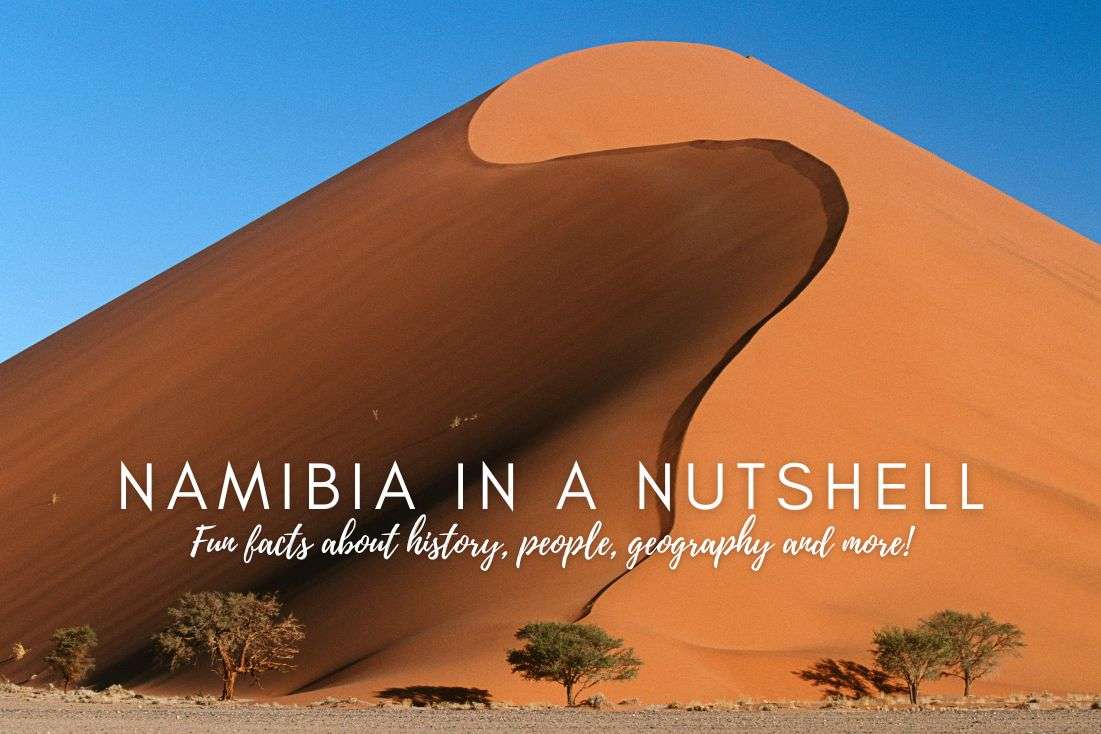
Namibia can seem like a daunting destination at first, especially if you're not accustomed to the stark, raw beauty (or is it?!) of its desert landscape. It's so immense you may feel like a tiny ant trying to explore an entire universe. And, with its population density ranking among the lowest in the world, you might wonder if there are any people around at all! But rest assured, the Namibians, once you find some, are friendly and welcoming, and you'll quickly find yourself feeling right at home in this desert wonderland.
With little rain and almost the entire country covered in desert, Namibia is a true test of one's endurance. But don't let that deter you; this country has one of the highest animal diversities in the world, both in the land and sea. And as a huge bonus (in my opinion), Namibia is a snake paradise!
Towns are scarce and, apart from Swakopmund, totally boring, making Namibia an entirely different experience and a unique destination worth visiting if you plan to explore the diverse animal life and take in the breathtaking scenery.
Let's dive into the fun facts of Namibia's history, politics, geography, people, culture, economy, religion, weather, and languages. Whether you're planning a trip to Namibia or simply want to learn more about this fascinating and oh-so-sandy country, this article is the perfect starting point.
So, buckle up, and let's dive into Namibia in a nutshell!
You might be interested in reading:
Namibia in a Nutshell: 10 Fun Facts
The Best Lodges in Namibia: 9 Places I Absolutely Loved
15 Tips for Self-Driving in Namibia: Avoid Common Mistakes
Your Namibia self-drive itinerary: Full trip plans for 10 and 14 days
Etosha National Park Safari: 9 Tips on Planning Your Perfect Visit
1. Namibia history timeline
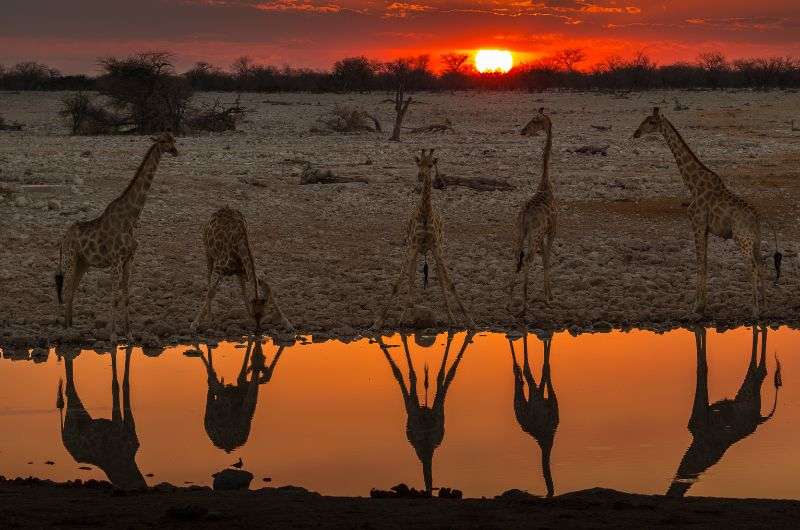
Namibia has a semi-boring history, and it only got “interesting” in the colonial era. But ain’t nobody got time for details, so here’s a quick and simple timeline of Namibia’s history:
- Pre-colonial era: For centuries, Namibia was inhabited by various ethnic groups, each with its own unique culture and traditions. It was a time when people lived off the land, roamed freely, and painted their faces with all sorts of funky patterns. First were the San people, who were later displaced by various Bantu-speaking groups.
- 1884: Enter the Germans. They come, they see, they conquer. The German Empire declares Namibia a colony and names it German Southwest Africa. Suddenly, everyone starts speaking German, wearing lederhosen, and drinking beer like it's going out of style.
- 1915-1920: World War I happens, and the Germans lose. South Africa swoops in and takes over the reins of Namibia. Suddenly, everyone starts speaking Afrikaans, wearing khaki shorts, and drinking rooibos tea like it's going out of style.
- 1948 to 1990: It wasn’t just questionable fashion that was brought by the South Africans. Apartheid was a dark period in Namibia's history. This policy of segregation and discrimination based on race was like a bad game of musical chairs, where certain groups were always left standing and excluded from the benefits and opportunities afforded to others. It wasn't until the early 90s that the music finally stopped and everyone was allowed to sit at the tablbae together.
- 1966-1990: The Namibian War of Independence rages on. Guerrilla fighters battle the South African apartheid regime in a bloody struggle for freedom. Eventually, peace prevails, and Namibia gains independence from South Africa in 1990. Suddenly, everyone starts speaking English, wearing khaki shorts (still), and drinking Windhoek Lager like it's going out of style.
- Present day: Namibia is a vibrant, multi-cultural country with a bright future. People from all over the world come to experience its natural beauty, explore its wildlife, and learn about its unique culture. And guess what? They all speak their own languages, wear whatever the heck they want, and drink whatever they like. That's the beauty of Namibia.
The legacy of colonialism and apartheid still looms large in Namibia, and the post-independence era hasn’t been challenge-free. However, Namibia has made great strides in recent years and is now considered one of Africa's most stable and safe democratic countries. Plus, I’m not mad about the great beers that are available thanks to the Germans! You know I have to include a subtle beer review in the fun facts about Namibia!
2. Namibia politics
Namibia is a presidential representative democratic republic. The president is both the head of state and the head of government and is elected by popular vote.
Namibia operates under a multi-party system, which is kinda like choosing between different flavors of ice cream—some may like vanilla, others may prefer strawberry, but at the end of the day, they're all ice cream cones fighting for political power.
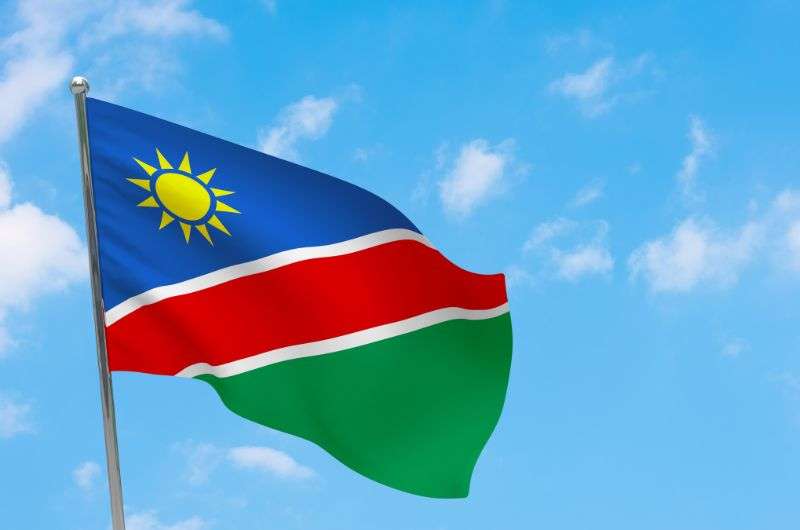
Even Namibia’s flag is all sunny
Since gaining independence from South Africa in 1990, Namibia's been rocking a presidential system of government. The current president is Hage Geingob.
The court system in Namibia is independent and operates on a three-tier system, just like a wedding cake.
I think the desert in Namibia is making me think about desserts too much. So, moving on to geography:
3. Namibia geography
Namibia is a big boy (girl?), measuring 825,615 km2 (about twice the area of California). Its length stretches about 1,300 km (808 miles), while its width averages around 800 kilometers (about 500 miles). And thanks to the Caprivi Strip, which is like the tongue of Namibia sticking out towards the northeast, Namibia has a little access to the Okavango and Zambezi rivers. So while the rest of Namibia is mostly a desert, the Caprivi Strip gives it a little splash of wetness.
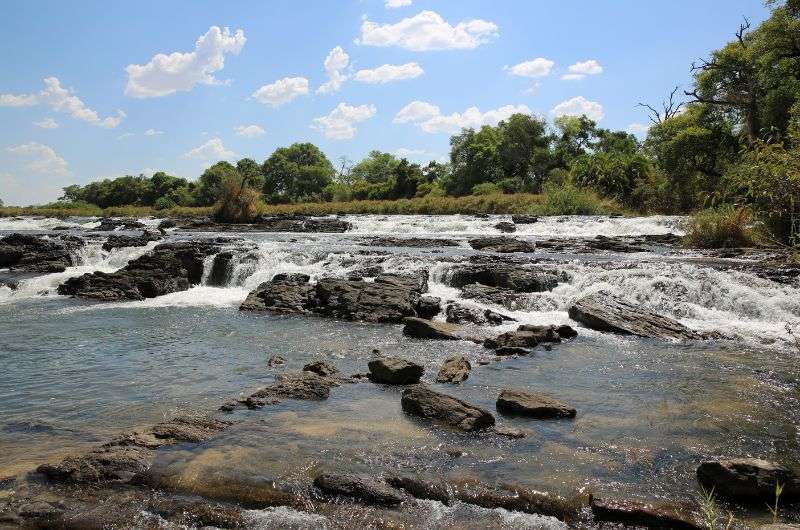
Popa Falls in Caprivi Strip
Luckily, Namibia also has a long shoreline and some mountains to spice up its geography. The country's coastline is a treat for the eyes, with the beautiful blue ocean contrasting against the never-ending orange sand dunes.
But first and foremost, it’s home to the oldest desert in the world, the Namib Desert. It’s one of the most surreal places on Earth, with towering red dunes that look like they were lifted straight out of a sci-fi movie. I’ve often mentioned that deserts suck the life right out of me, but there are a few exceptions where I feel undoubtedly alive—like during quad biking near Swakopmund or even while exploring the skeleton trees of Sossusvlei (ironic, I know).
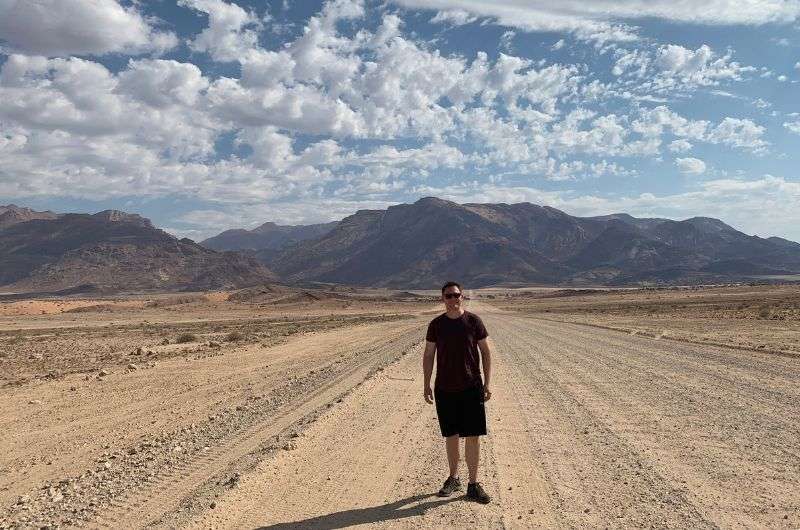
Sand, sand, sand... and then boom! Mountains!
Inland, the desert gives way (but not too much) to some mountains, like the magnificent Mt. Brandberg and Königstein, the highest peaks in Namibia. And let's not forget the savannas—Etosha National Park is Namibia’s safari hotspot and home to a surprising variety of wildlife. There’s even the second largest canyon in the world in the far south, Fish River Canyon.
Overall, Namibia's geography is a major draw for tourists, offering a unique and diverse experience that is unlike any other in Africa. You can stay is some fantastic lodges and resorts in Namibia to give yourself a good level of comfort while surrounding yourself with said unique nature (and perhaps staring at rhinos from your window, like at Burgsdorf Guest Farm, or hearing cheetahs chirping right by your patio at the Babson House).
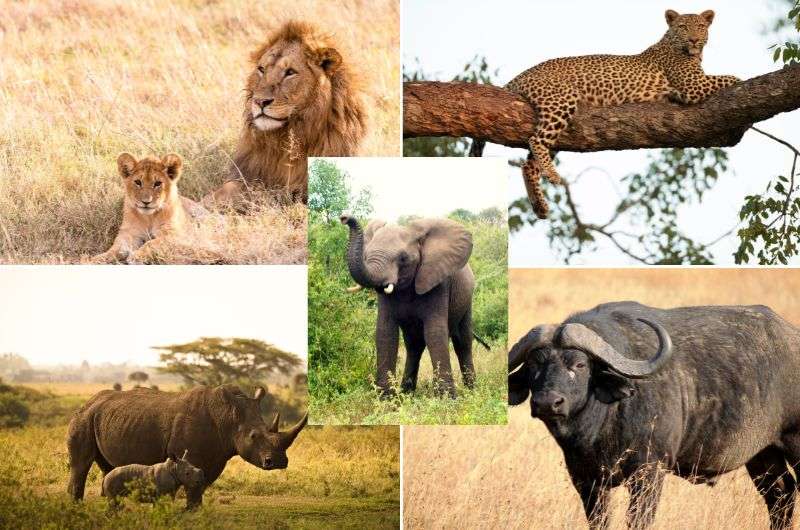
The big 5 of Namibia!
Tip: Driving in Namibia can be challenging due to long distances between destinations, gravel and sand roads, and wildlife not caring if they jaywalk, all of which means slow travel times and bumpy rides. Read my tips on self-driving in Namibia before you set out.
As far as its neighbors go, Namibia has borders with Angola to the north, Zambia and Zimbabwe to the northeast, Botswana to the east, South Africa to the southeast and south, and the Atlantic Ocean to the west. Namibia's capital, Windhoek, is roughly in the center of the country.
4. Namibia economy
Now let's talk about money, honey. Namibia's GDP per capita is around USD 9,800, which is not too shabby, putting it in 12th place out of 54 countries in Africa.
A less great fun fact: It also has the second-highest Gini coefficient in the world. No, that's not some fancy math equation you learned in school. It's a measure of income inequality, and Namibia's high score is nothing to laugh about. Only South Africa beats it. So, while some (not a lot of) Namibians are living large, others (a lot) are struggling to get by.
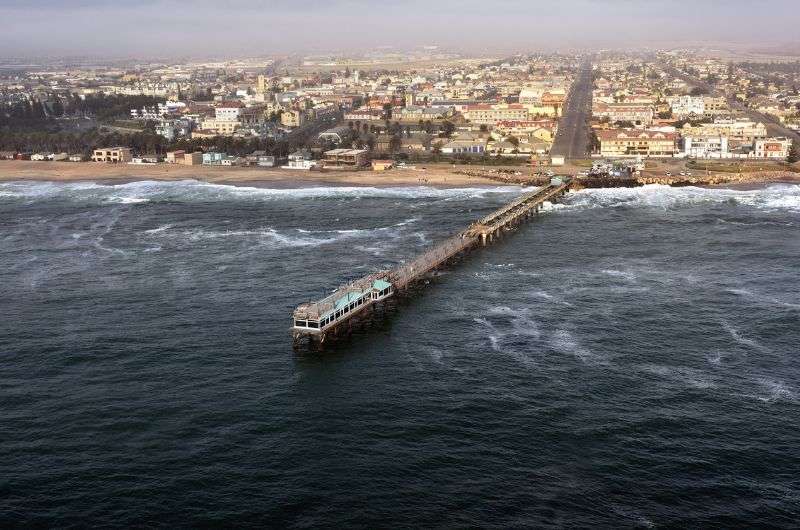
The city of Swakopmund in Namibia
Namibia's economy is largely dependent on mining, especially diamonds, which account for a third of its export earnings. The country also has rich reserves of uranium, gold, silver, and other metals. But again, don't let all those sparkly things fool you, the majority of the population lives in poverty, while a small elite holds most of the wealth.
To make things even worse, Namibia is heavily dependent on its neighbor (and former colonizer) South Africa, which is where most of its exports go and it’s the source of many imports as well. This means that when South Africa's economy takes a hit, Namibia feels the pain too. And honestly, being dependent on a country from which they are finally independent, must feel pretty shitty.
Tourism is also a significant part of Namibia’s economy, so download that itinerary and head over there already!
5. Namibia currency and prices
Namibia's currency is the Namibian dollar, written as NAD or N$. It’s linked to the South African rand (ZAR) at a 1:1 ratio. The rand is still legal tender in Namibia, some 33 years after Namibia gained independence from South Africa. Annoying much?
The exchange rate between the NAD and other currencies is usually based on the ZAR exchange rate. There goes South Africa again, being all bossy.
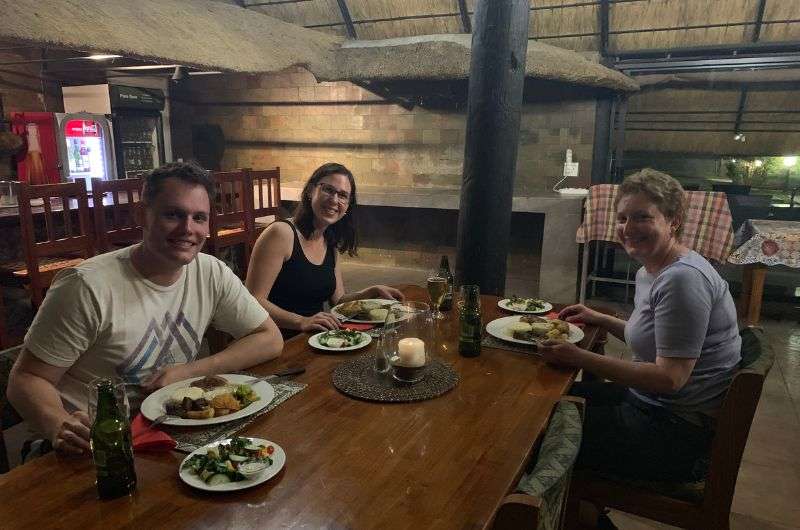
This is us, happy in Burgsdorf Guest Farm
Is Namibia expensive?
Overall, Namibia is a bit more expensive than some other African countries, but it's definitely not as pricey as, say, a trip to Europe or the United States.
As of May 2023, here are some sample exchange rates:
1 USD or EUR = 19 NAD
1 GBP = 24 NAD
1 AUD = 12.5 NAD
And some prices to compare that to:
Fuel price = 19 NAD (1 liter of gas)
Beer (0.5 liters) = 30 NAD
Tickets to Etosha National Park = 80 NAD
Meal in a good restaurant = 150 NAD
Room at Ijaba Lodge or at Burgsdorf Guest Farm (our favorite lodges in Namibia!) = 1500 NAD
6. Namibia demographics
Namibia is great news for introverts and anyone who finds small talk excruciating—it's one of the largest countries in Africa, but the population is just 2.5 million people. That's about the same population as the city of Paris but spread over an area 1.5 times the size of France!
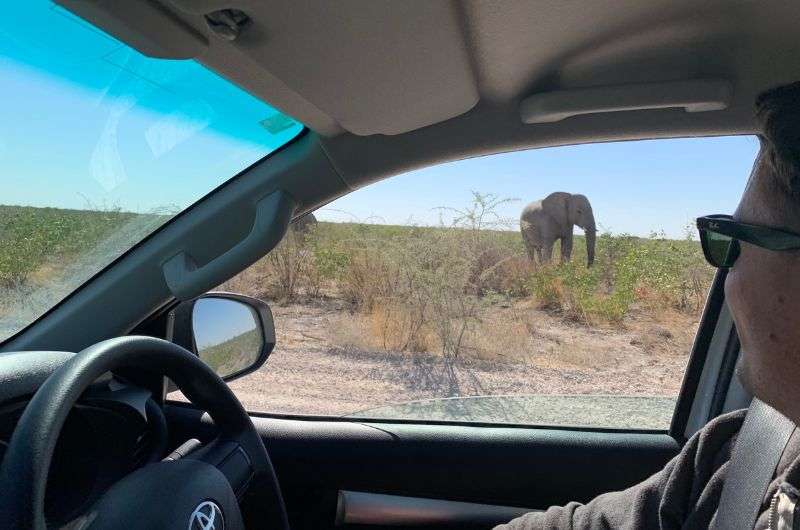
There are not many people in Namibia. However, here you have the opportunity to meet animals that you will not meet anywhere else. Especially in Etosha National Park
The population density of Namibia is just 3 people per km2. That’s a lot of room to breathe, stretch out, and avoid awkward conversations with strangers. If you still need more alone time, you’ll need to head to Greenland or Mongolia, because everywhere else on this planet is more crowded.
Namibia’s population is made up of several ethnic groups—they've got a ton of Bantu-speaking people, mostly Ovambo, living up north. Then you've got the Herero and Himba people who are known for their traditional hairstyles and dress (or rather, undress). And don't forget about the Damara, who speak a "click" language, which is utterly fascinating to us non-clicking folks. There are also the San and Nama people who are descendants of the original cultures of Southern Africa, as well as a few refugees from Angola.
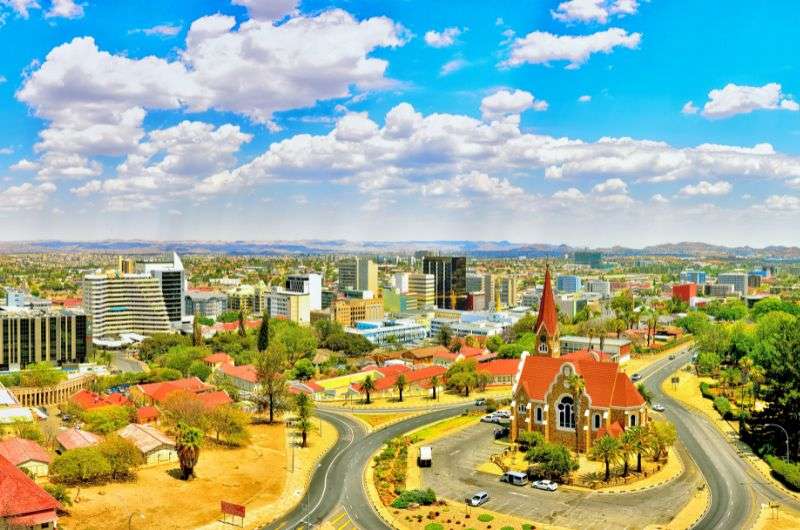
The capital city of Windhoek
Whites make up a small portion of the population, but they still hold a lot of land due to colonialism. There are some Germans, Portuguese, and Afrikaners who maintain cultural ties to their home countries.
Most of the country’s population is concentrated in the capital city of Windhoek, as well as the coastal adventure center of Swakopmund, where you might even feel like you’ve been teleported to a small, sandy town in Germany. These bigger towns are where you’ll find the majority of White Namibians.
7. Namibia Languages
Given how sparsely populated Namibia is, there are a surprising number of languages being spoken in the country. This is due to the multitude of indigenous languages used by the various tribes.
English is the sole official language in Namibia, meaning you as a traveler will have an easy time reading things such as signs and menus, but only 3% of the people in Namibia use English as their native language. If you are traveling outside of the capital (and I say get the heck out of there and continue on your itinerary asap!), you’ll do yourself a favor if you also learn a few basic phrases in Afrikaans. A majority of people with different native languages outside of the bigger cities will speak more of the Dutch-sounding Afrikaans than English.
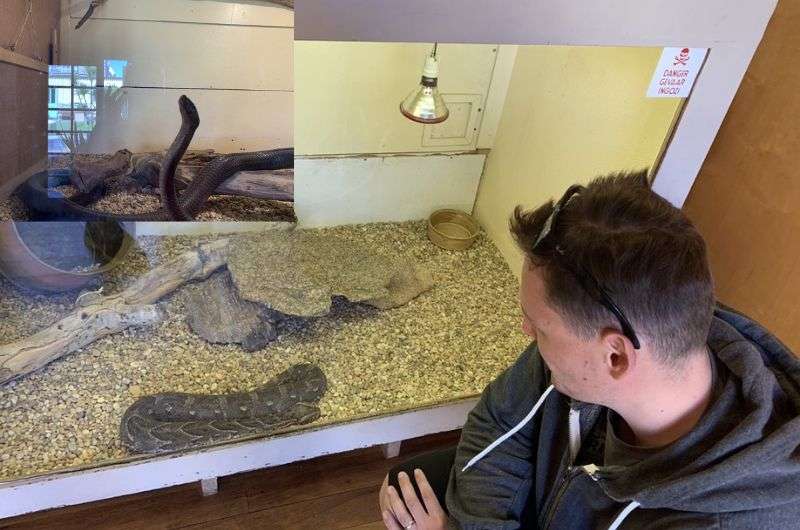
I enjoyed chatting with these lovelies in Snake Park in Swakopmund
The language you’ll hear most of the Namibian population speaking is Oshiwambo. Among White Namibians, 60% speak Afrikaans, 32% speak German, and only 7% use English as their first language.
Khoisan languages are spoken by tribes such as the Damara, and that means one thing—clicking! You may even stumble upon a guide or a member of the staff at your accommodation that will know how to make those 4 clicking sounds. Just don’t be a Karen about it, shoving a phone in their face while making a video for Instagram like they’re some kind of spectacle. Some people *eye roll*. And another fun fact: No, you probably won't be able to pronounce anything with a clicking sound.
8. Namibia religion
When it comes to religion in Namibia, Christianity is the name of the game—97% of the population identifies as Christian, though Namibia is a secular state officially, and it allows freedom of religion.
It seems like Namibians take their Christianity pretty seriously, with churches playing a big role in communities all over the country. It's worth noting that there are many variations of the religion, with the Lutheran Church being the most popular.
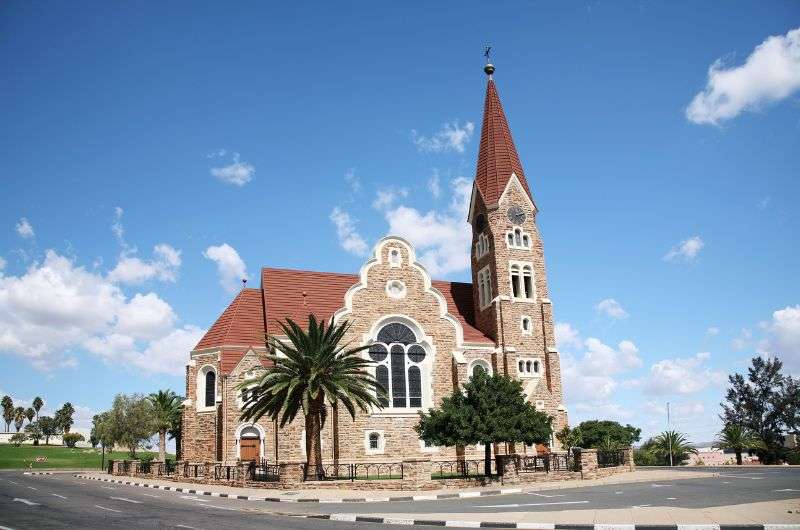
The Christ Church in Windhoek
There are also Muslim and Jewish communities in Namibia, and even some Buddhists and maybe even an atheist or two wandering around somewhere out there in the vast desert.
In rural areas, some traditional indigenous beliefs are also practiced. The Himba people, for example, follow practices that involve ancestor worship and animal sacrifice. And speaking of animals, some Namibians also practice a form of animism, which is the belief that all things have a spirit or soul.
Whether it's Sunday church or mosque on Fridays, religion is a big deal in Namibia. It's not just about believing in a higher power, it's a way of life for many Namibians, and an important part of their cultural heritage.
9. Namibia weather
Sure, it’s almost all desert, but Namibia's climate varies depending on where you are in the country. The coast is cooler than the interior, with temperatures typically hovering around a comfortable 20°C (68°F) during the day throughout the year.
Inland areas, especially in the north and east, can be hot all year round, with winter temperatures exceeding 30°C (86°F) during the day, or, if you are some sort of masochist that visits in the summer, 40°C (104°F), easy. The summer months, from November to February, are the hottest.
No matter where you are, though, beware nights get cold in the winter! And I mean freezing cold.
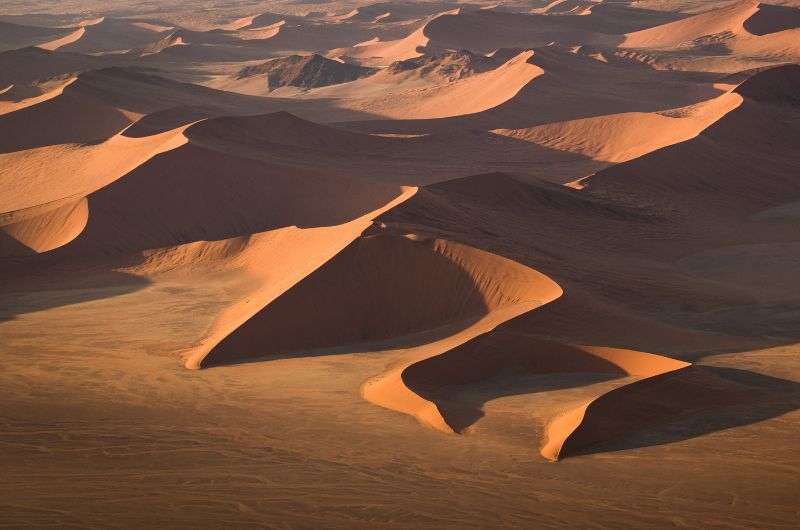
Namib Desert from a helicopter—like a wild, orange ocean
When’s the best time to visit Namibia?
The best months to visit Namibia are May to September, which are the winter months. That’s when the weather is the most comfortable and you won’t burn to ash in the inland areas. There will also be no rain, which may or may not be a good thing.
Remember, being in the desert in the winter, when days are still warm (or even hot), still means that nights can surprise you with their coolness, so don’t leave that jacket at home.
Which month is best for Namibia safari?
May to September is the best time to visit Etosha National Park, with no rain and pleasant daytime temperatures of around 27°C (80°F). But don't let the mild temperatures fool you; it can get below freezing at night.
The only reason you could have to visit Namibia in the summer months is that you really hope to see baby animals in the safari. If daytime temps around 40°C (104°F) and some rain don’t scare you, go ahead and find that baby black rhino!
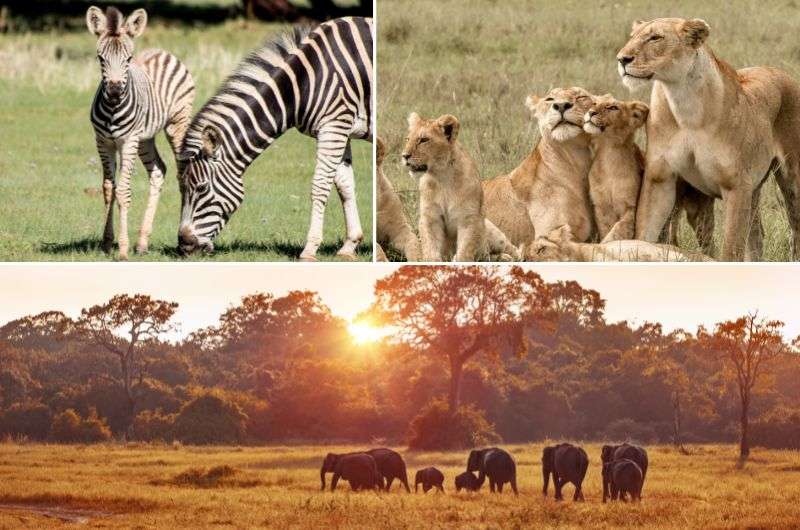
In Etosha National Park, It’s like National Geographic but you’re part of the show!
10. Namibia holidays, customs, and famous people
If you ignore my recommendation to travel to Namibia between May and September, you could witness Independence Day. March 21st marks the glorious day when Namibia finally broke free from South Africa's clutches and gained its independence. Namibians come together, waving their flags high, and the streets are alive with parades, music, and dancing. It’s a day to be a loud and proud Namibian!
But wait, there's more! Heroes' Day, celebrated on August 26th, is another significant event on Namibia's calendar. It's like the prequel to Independence Day, the day when the curtain was raised on the armed struggle against the South African occupation. It honors the heroes and heroines who fought to reclaim their land and restore freedom to Namibia.
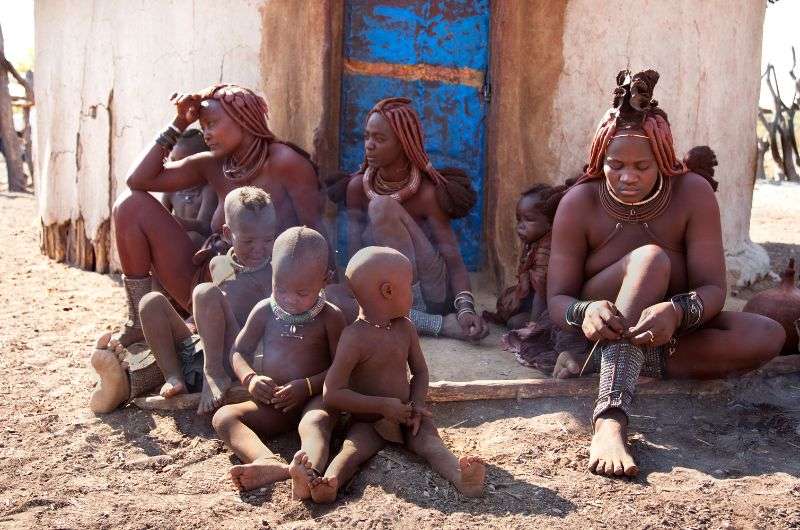
Members of the Himba tribe
No matter what the holiday or cultural event—and there are many, thanks to the diversity of Namibia’s tribes and ethnic groups—there's always music and dancing. Namibians have rhythm in their DNA! Traditional music is a tapestry of sounds, blending African beats with modern influences. Namibians love to dance, and they have some killer moves up their sleeves.
If you decide to join in or just spectate, just remember that elders are highly respected in Namibia, so follow suit and bring your manners, and if granny is up there trying to bust a move, treat her like royalty.
One thing that isn’t respected in Namibia? Time. Let’s just say Namibians have a more relaxed approach to time, and being fashionably late is common.
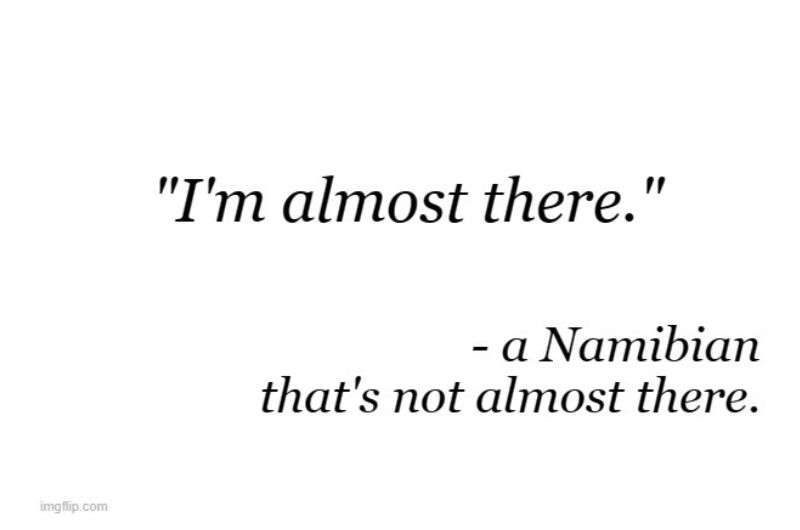
As for famous Namibians:
- Frankie Fredericks is like The Flash, and he was Namibia's only able-bodied Olympic medalist until Christine Mboma came along and won a silver medal at the 2020 Olympics in Tokyo.
- Behati Prinsloo, Victoria's Secret model and wife of Maroon 5’s Adam Levine, also hails from Namibia. Speaking of Hollywood, Shiloh Jolie-Pitt was born in Swakopmund, so it kind of counts, right?
- If you’re looking for musicians that have made it in the Namibian biz, take a look at Gazza, King Tee Dee, Lady May or Top Cheri.
- Samuel Nujoma, Namibia's first President from 1990 to 2005, led the nation with the tenacity of a lion on the savannah. With his unwavering dedication and fierce determination, Nujoma left an indelible mark on the history of Namibia, setting Namibia up for a brighter future.
This post contains affiliate links. I earn a small commission if you make bookings through my links, at no additional cost to you. This helps keep this blog free, thank you!
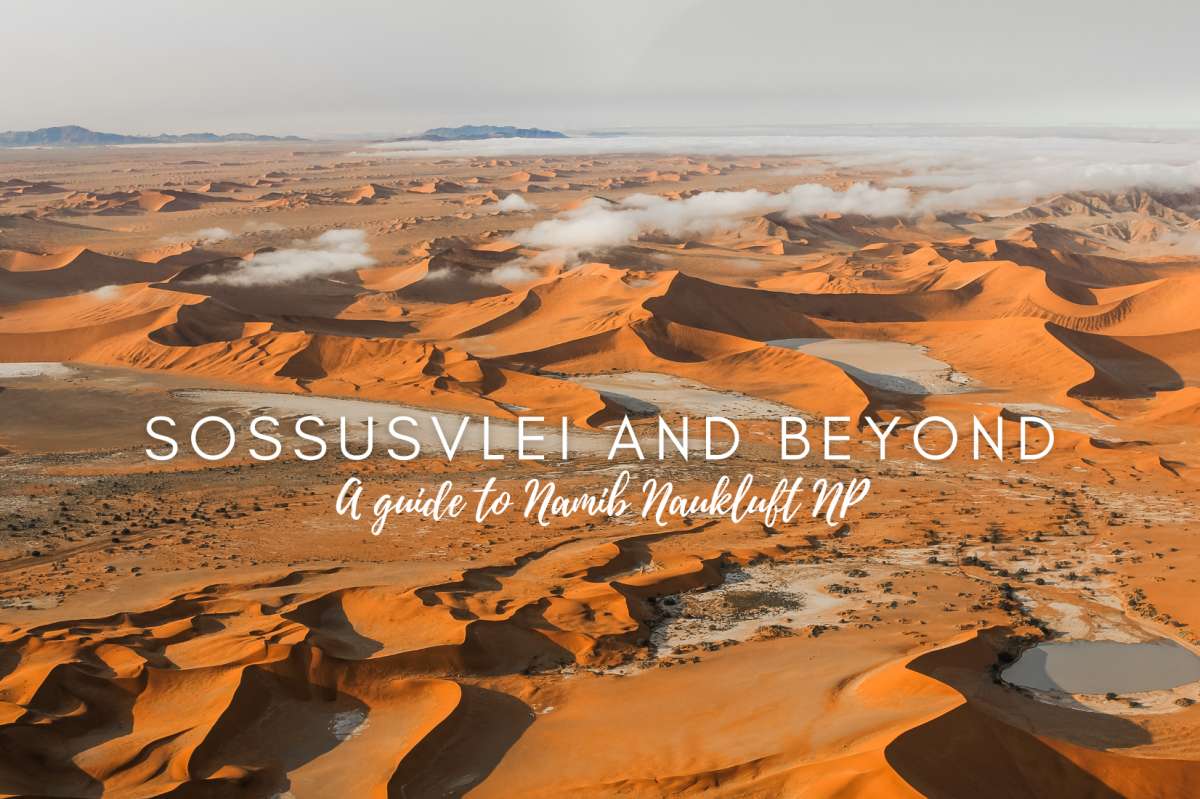
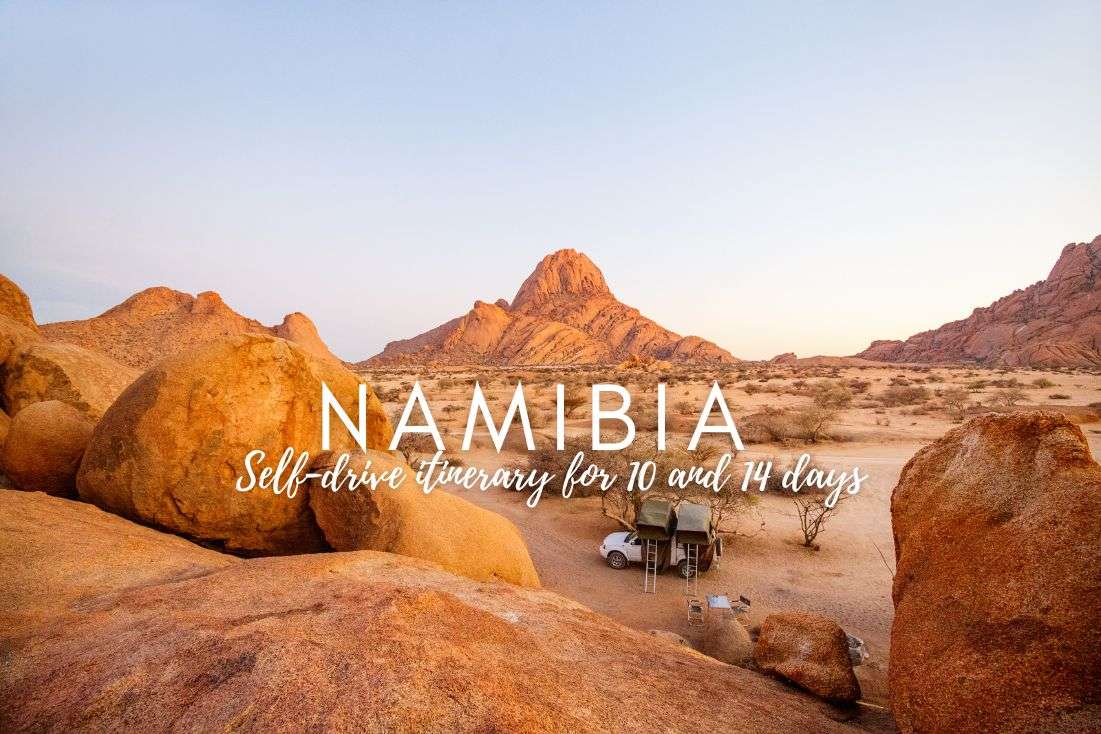
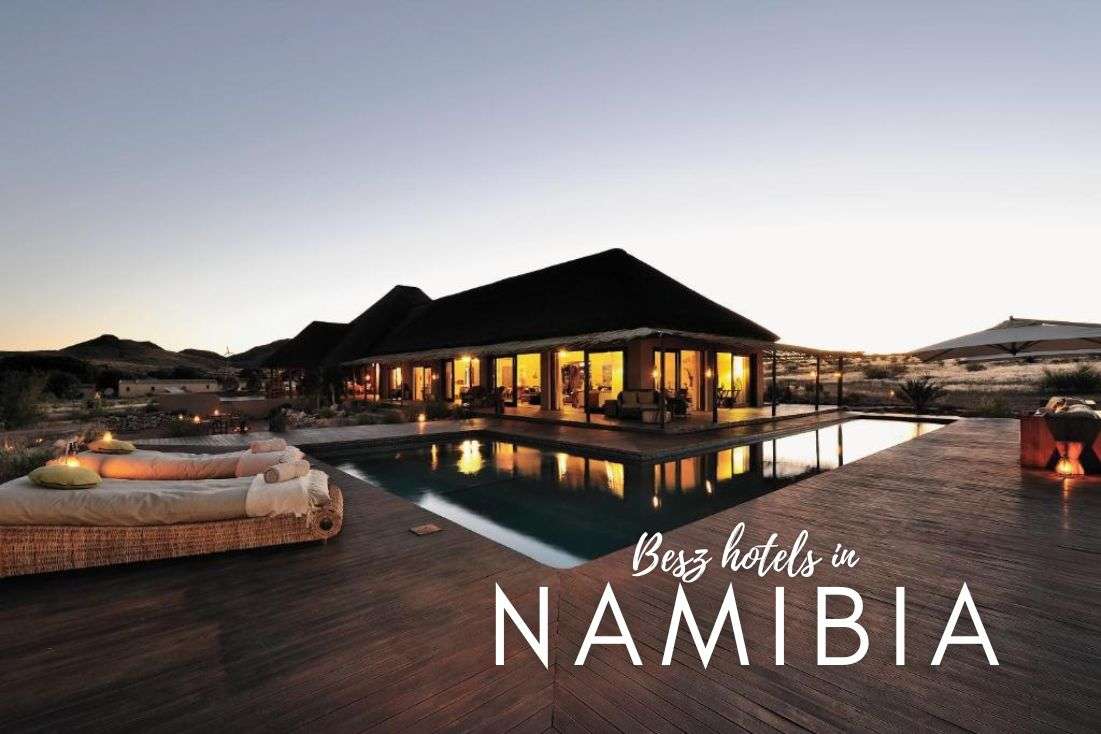




Comments
Thoughts? Give us a shout!